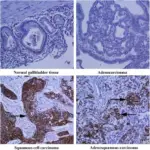Adenocarcinoma of the gallbladder is cancer that begins in the glandular cells that line the inner surface of the gallbladder.
What is the Pathology of Adenocarcinoma of the Gallbladder?
The pathology of adenocarcinoma of the gallbladder is:
-Etiology: The cause of adenocarcinoma of the gallbladder isn’t clear. Factors that can increase the risk of gallbladder cancer include a history of gallstones, alcohol use, and gallbladder inflammation.
-Genes involved: K-ras
-Pathogenesis: The sequence of events that lead to adenocarcinoma metaplasia or dysplasia.
-Morphology: The morphology associated with adenocarcinoma of the gallbladder shows thickened and indurated gallbladder wall, exophytic or polypoid friable mucosal lesions.
-Histology: The histology associated with adenocarcinoma of the gallbladder shows malignant glandular proliferation.
How does Adenocarcinoma of the Gallbladder Present?
Patients with adenocarcinoma of the gallbladder typically are older females. The symptoms, features, and clinical findings associated with adenocarcinoma of the gallbladder include abdominal pain, particularly in the upper right portion of the abdomen, abdominal bloating, weight loss, and jaundice.
How is Adenocarcinoma of the Gallbladder Diagnosed?
Adenocarcinoma of the gallbladder is diagnosed with biopsy.
How is Adenocarcinoma of the Gallbladder Treated?
Adenocarcinoma of the gallbladder is treated with surgery, chemotherapy, or radiation therapy.
What is the Prognosis of Adenocarcinoma of the Gallbladder?
The prognosis of adenocarcinoma of the gallbladder is poor.


